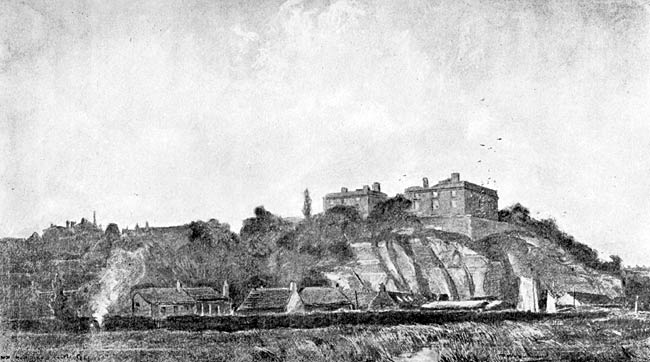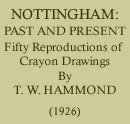< Previous | Contents | Next >
NOTTINGHAM PAST & PRESENT: THE CASTLE
THE CASTLE, 1869

This drawing gives us an excellent idea of what Nottingham Castle looked like before the present buildings were opened in 1875. The ruins here shown are all that was left of the magnificent palace, which was erected by the first Duke of Newcastle about the year 1679 and almost completely destroyed by the Reform Bill Rioters in 1831. The Duke was his own architect and it is very interesting to notice in the details of his building the struggle between the old Gothic spirit of architecture, which had hitherto obtained, and the new Renaissance feeling, which was then struggling for expression, and when one stands upon the platform of the Castle grounds and looks over towards W )llaton Hall where this battle between the two architectural ideals is even more strikingly exhibited, these features become perfectly fascinating.
At the foot of the Castle cliff, are shown some buildings which were the warehouses of the 'Duke's Wharf, as it was called; then a very important business section of Nottingham. Just to the west of these wharfs was a district which was called 'Spa Close', because in it was situated a mediaeval well, whose chalybeate waters were of considerable note up to the middle of last century. Behind this Spa Close was the fish pond of the Castle and in the foot of the rock upon which the castle stands, still remains a rock-hewn house, which was used as a depository for fishing tackle. In the seventeenth century this fish pond was leased to the Nottingham Water Works Company, but owing to neglect, it gradually became silted up and turned into a noisome marsh overgrown with reeds. This was filled up in 1792 by soil taken from the foundation of the barracks which were situated at the upper end of the Park and of which some few fragments still stand in the court yard at the end of Barrack Lane.
This newly made land was divided up into gardens and was so prolific that the Fish Pond Gardens were celebrated for their produce and beauty even in a town so much devoted to gardening as Nottingham.
One of the features of Nottingham Park, which is well shown in this picture, is its wealth of trees. It is interesting to remember that Mrs. Hutchinson in her 'Memoirs' says that in her day (that is some time about 1650), there was only one tree in the Park and that was upon the Castle Rock.
